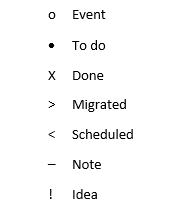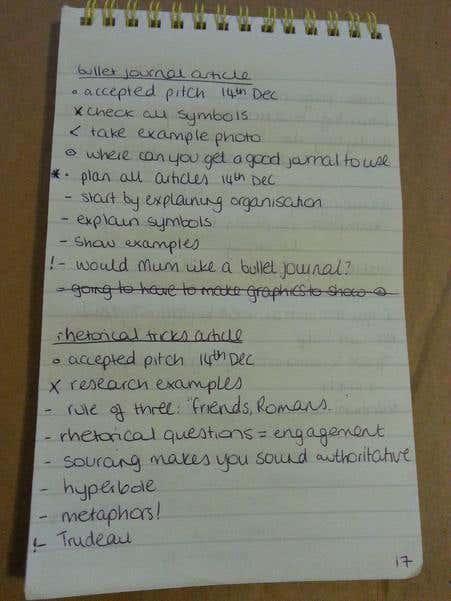One of the latest trends I’ve come across in recent months is the idea of using a “bullet journal,” or a single notebook that combines all your lists, memos and ideas in an easy-to-find format. The four key features highlighted by the originator of the idea are:
- Topics
- Page numbers
- Short sentences
- Bullets
These allow you to organize just about anything while presenting your to-do lists in an accessible format.
Topics
A topic is like a page header that's simple but descriptive. My topic heading for the page of my bullet journal where I planned this, for example, was just ‘bullet journal article’.
Page numbers
This allows you to set up an index. If I want to find my schedule for December, I can just look at my index page and discover that it’s on pages 8-9. Because the pages are numbered, I can easily find that.
Short sentences
The bullet journal format encourages you to note facts and events in short sentences. Rather than writing at length, you just note something down in order to keep track of it – whether it’s “Mum’s birthday 19th” or “Grandma into hospital 1st Jan”.
Bullets
The bullets are the key feature of a bullet journal, as it provides a quick way of showing the status of a task. A single bullet tells you there’s a task you still need to do, while an X shows that you’ve completed it.
Setting Up a Bullet Journal
You don’t have to do much to set up a bullet journal. Just grab a notebook that you can easily carry around, and set aside the first few pages as an index. Then you need to set up a ‘future log’ – a page for the next few months to note down key dates, like birthdays and appointments. You can adapt this to your anticipated needs: my future log covers December to May in two pages, but you may need more or less space.
Next up is a monthly log. On one page, write down all the days in the month and quickly note down the day of the week, too. Then you can write in appointments, birthdays, and other entries for the whole month, and you have a quick reference point for what day is Friday. On the facing page, jot down things you need to do and things you need to schedule.
Symbols
These symbols, at the left margin of the page, show you the status of a task. Here’s a quick key, but you might adapt it for yourself:

In addition to these symbols, you can add an asterisk to the left of any symbol to make it stand out as something important. There is an additional symbol in the official version that reminds you of something you need to research or explore, denoted with a little eye.
Note: One of those symbols—the one for migration—needs a little bit more explanation, and is a key part of the bullet journal concept.
Migration
Migration refers to the act of going through your lists and checking for tasks you haven’t done. Do you need to add them to an ongoing list of tasks for the next month? Have they become irrelevant? Did you get them done? This process crosses off tasks you’ve done, checks in on the status of other tasks, and reminds you to plan ahead for the next days, weeks and months.
A bullet journal is a versatile way of organizing your to-do list, with symbols that provide visual reminders of the status of various jobs. As an example, here’s a page from my own bullet journal, written to plan this article.
